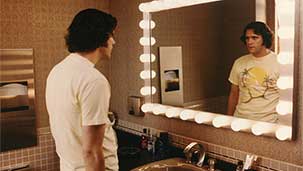Conventional wisdom says that if you want to know if someone is telling the truth you should look them in the eye. Of course eye contact doesn’t really prove anything, but it does make human interaction feel more intimate. Which is likely why director Chris Smith hired you to operate the Interrotron, a device developed by documentary filmmaker Errol Morris. The machine allows the subject being interviewed to look directly at the person asking the questions, while also seemingly looking straight into the camera. And when someone is revealing a side of themselves you’ve never seen, like Jim Carrey in Jim and Andy: The Great Beyond - Featuring a Very Special, Contractually Obligated Mention of Tony Clifton, it’s particularly affecting.
Your interview is also the only new footage created for this documentary that looks back on the making of the 1999 film Man on the Moon. Cutting together what feels like an endless supply of behind-the-scenes footage, Smith gives us an idea of what a nightmare - and surrealist comedy - it must have been to work on the biopic about Andy Kaufman. Carrey’s refusal to break character was widely reported, but you really don’t get a sense of what that means until you see this film. With the distance of time, and a camera, watching all the other actors, crew, and especially director Milos Foreman, plead to get just a moment where they can “speak to Jim” is pure anarchy and hilarity.
But as Carrey says in the interview, Jim Carrey simply wasn’t on this planet for a few months.
Carrey himself never betrays the truth he lived during that winter of filming in Los Angeles. Method acting is not an accurate description for his approach. Carrey quite literally felt like he was channeling Kauffman’s spirit during production. Which became extra problematic, since Kauffman himself made a career of blurring the lines between reality and entertainment.
Carrey still speaks of that time as what “Andy didÆ or what he did through Andy. It was a complete break from the crowd-pleasing comedy superstar he had become, and one gets the feeling he never fully reconnected with the person he once was afterwards.
It all makes for a completely engrossing and fascinating documentary that proves there was a far more experimental and ambitious film to have been made about Kauffman’s life (and maybe Carrey’s) than what we got from Man on the Moon. The pure befuddlement of Danny DeVito, and grinding contempt from players like Paul Giamatti, is palpable - especially in the earliest stages of production. Kaufman’s own megalomaniacal alter ego Tony Clifton, when portrayed by Carrey, is especially grating behind the scenes (and far more hilarious via the documentary than the feature film ever conveyed).
Man on the Moon never allowed Carrey to transition into a serious dramatic actor, but he did seem to become a more serious person, which wasn’t always for the best, as his bouts of depression and existential dread feel extra soul-crushing when he describes them looking straight into the camera. But it sure made him a more compelling character. Which may have been his ultimate goal, film or not.
Sincerely,

Christopher







